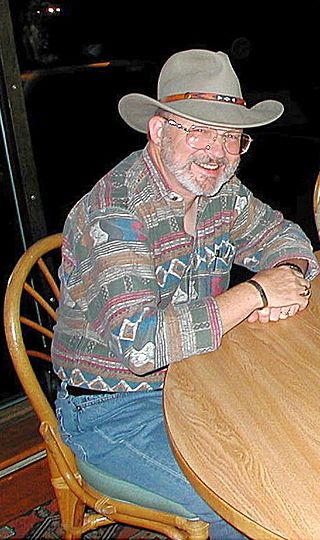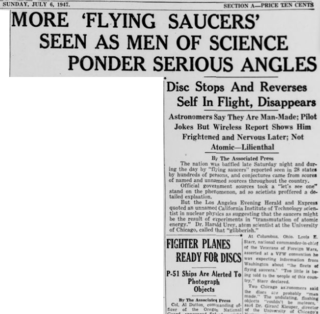
The Lockheed U-2, nicknamed "Dragon Lady", is an American single-engine, high altitude reconnaissance aircraft operated from the 1950s by the United States Air Force (USAF) or the Central Intelligence Agency (CIA). It provides day and night, high-altitude, all-weather intelligence gathering.

The "Roswell incident", or simply "Roswell", was the July 1947 recovery of metallic and rubber debris from a crashed military balloon by Roswell Army Air Field personnel, who issued a press release announcing possession of a "flying disc". Decades later, conspiracy theories claimed that debris from an alien spaceship had been covered up by the government. In response, in 1994 the United States Air Force published a report concluding the crashed object was a top secret nuclear test surveillance balloon from Project Mogul.
On January 7, 1948, 25-year-old Captain Thomas F. Mantell, a Kentucky Air National Guard pilot, died in the crash of his P-51 Mustang fighter plane near Franklin, Kentucky, United States, after being sent in pursuit of an unidentified flying object (UFO). The event was among the most publicized early UFO incidents.
Black project is an informal term used to describe a highly classified, top-secret military or defense project that is not publicly acknowledged by government, military personnel or contractors.
A bhangmeter is a non-imaging radiometer installed on reconnaissance and navigation satellites to detect atmospheric nuclear detonations and determine the yield of the nuclear weapon. They are also installed on some armored fighting vehicles, in particular NBC reconnaissance vehicles, in order to help detect, localise and analyse tactical nuclear detonations. They are often used alongside pressure and sound sensors in this role in addition to standard radiation sensors. Some nuclear bunkers and military facilities may also be equipped with such sensors alongside seismic event detectors.

Kapustin Yar is a Russian rocket launch complex in Astrakhan Oblast, about 100 km east of Volgograd. It was established by the Soviet Union on 13 May 1946. In the beginning, Kapustin Yar used technology, material, and scientific support gained from the defeat of Germany in World War II. Numerous launches of test rockets for the Russian military were carried out at the site, as well as satellite and sounding rocket launches. The towns of Znamensk and Kapustin Yar were built nearby to serve the missile test range.

Skyhook balloons were high-altitude balloons developed by Otto C. Winzen and General Mills, Inc. They were used by the United States Navy Office of Naval Research (ONR) in the late 1940s and 1950s for atmospheric research, especially for constant-level meteorological observations at very high altitudes. Instruments like the Cherenkov detector were first used on Skyhook balloons.

Balloons and kites were the first inventions used in aerial warfare and their primary role was observation. Balloons provided a reliable and stable means of elevating an observer high over the battlefield to obtain a birds-eye view of troop positions and movements. An early instrument of aerial intelligence collection, they were also useful for creating accurate battlefield maps, an important ingredient for battlefield success. Incendiary balloons also have a long history. The incendiary balloons carry hot air or something that can catch fire to destroy enemy territory. They could also hold small bombs for combat. The history of military ballooning dates back to the late 18th century, when the Montgolfier brothers, Joseph-Michel and Jacques-Étienne, first demonstrated the potential of hot-air balloons for military use. The first recorded military use of balloons was during the French Revolutionary Wars, when the French military used balloons to gather intelligence on the movements of the enemy. Balloons were also used during the American Civil War, where they were used for reconnaissance and communication.

An observation balloon is a type of balloon that is employed as an aerial platform for gathering intelligence and spotting artillery. The use of observation balloons began during the French Revolutionary Wars, reaching their zenith during World War I, and they continue in limited use today. Synonyms include espionage balloon, reconnaissance balloon, spy balloon, and surveillance balloon.
Project 119L was a Cold War reconnaissance operation by the U.S. Air Force in which large espionage balloons floated cameras over the Soviet Union.
Charles Bachman Moore Jr. was an American physicist, engineer and meteorologist, known for his research on atmospheric physics and his work with gas balloons. He was born in Maryville, Tennessee.

Project Genetrix, also known as WS-119L, was a program run by the U.S. Air Force, Navy, and the Central Intelligence Agency during the 1950s under the guise of meteorological research. It launched hundreds of surveillance balloons that flew over China, Eastern Europe, and the Soviet Union to collect intelligence on their nuclear capabilities. The Genetrix balloons were manufactured by the aeronautical division of General Mills. They were about 20 stories tall, carried cameras and other electronic equipment, and reached altitudes ranging from 30,000 to over 60,000 feet, well above the reach of any contemporary fighter plane. The overflights drew protests from target countries, while the United States defended its action.

Karl Tomlinson Pflock was a CIA intelligence officer, Deputy Assistant Secretary of Defense in the Reagan Administration, strategic planner, UFO researcher, and author of both fiction and non-fiction. He was best known for his book Roswell: Inconvenient Facts and the Will to Believe.
A restricted military area or military out-of-bounds area is an area under military jurisdiction where special security measures are used to prevent unauthorized entry.
For environmental monitoring, Project Grab Bag was an air sampling program conducted in the United States in the stratosphere of above-ground nuclear weapons testing in the Soviet Union.

Between 1946 and 1960, the United States Air Force conducted aerial reconnaissance flights over the Soviet Union in order to determine the size, composition, and disposition of Soviet forces. Aircraft used included the Boeing B-47 Stratojet bomber and—from 1956—the Lockheed U-2 spy plane specifically designed for high-altitude reconnaissance flight. The overflight program was ended following the 1960 U-2 incident.

The 6021st Reconnaissance Squadron is an inactive United States Air Force unit. Its last was assigned to the 67th Tactical Reconnaissance Wing, stationed at Yokota Air Base, Japan. It was discontinued on 8 December 1957.

Jesse Antoine Marcel Sr. was a lieutenant colonel in the United States Air Force who helped administer Operation Crossroads, the 1946 atom bomb tests at the Bikini Atoll.

The 1947 flying disc craze was a rash of unidentified flying object reports in the United States that were publicized in the summer of 1947. The craze began on June 24, when media nationwide reported civilian pilot Kenneth Arnold's story of witnessing disc-shaped objects which headline writers dubbed "Flying Saucers". Such reports quickly spread throughout the United States; historians would later chronicle at least 800 "copycat" reports in subsequent weeks, while other sources estimate the reports may have numbered in the thousands.

The Roswell Incident is a 1980 book by Charles Berlitz and William Moore. The book helped to popularize stories of unusual debris recovered in 1947 by personnel of the Roswell Army Air Field.














